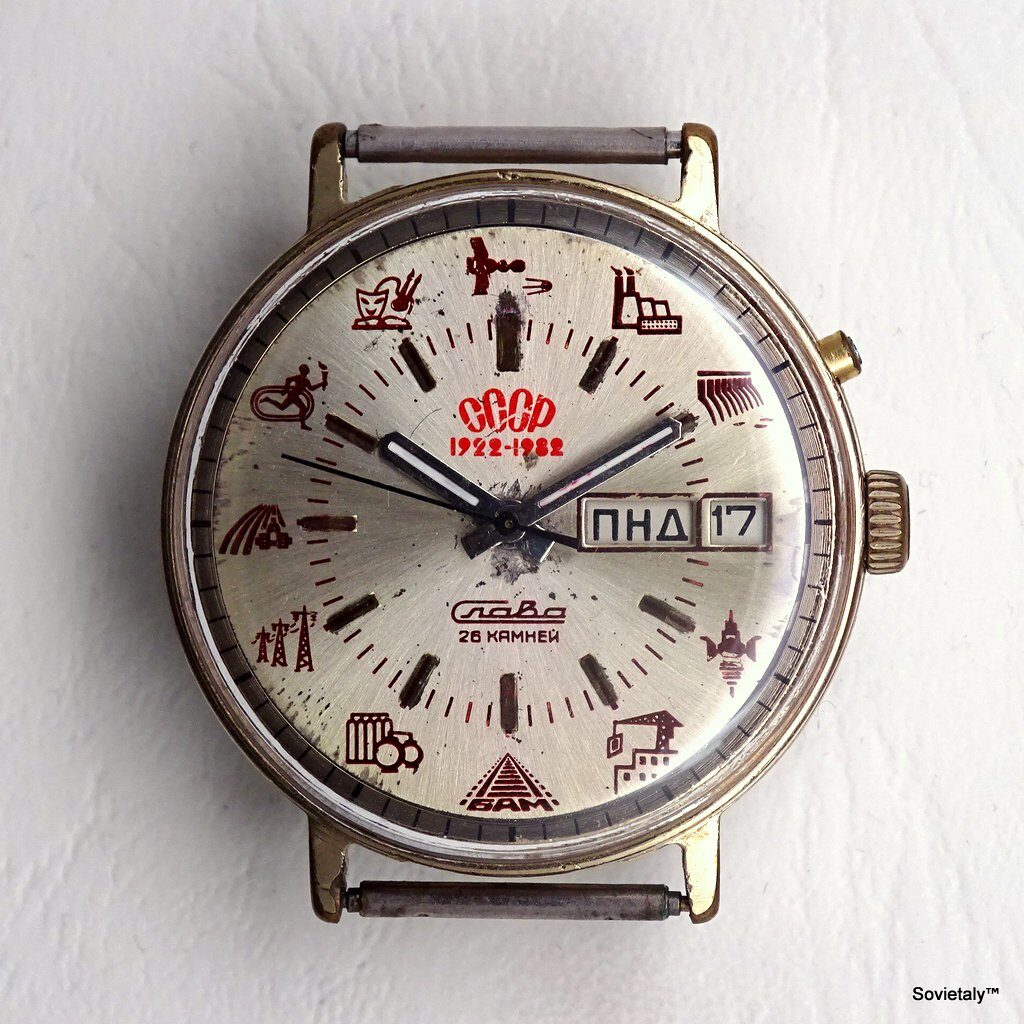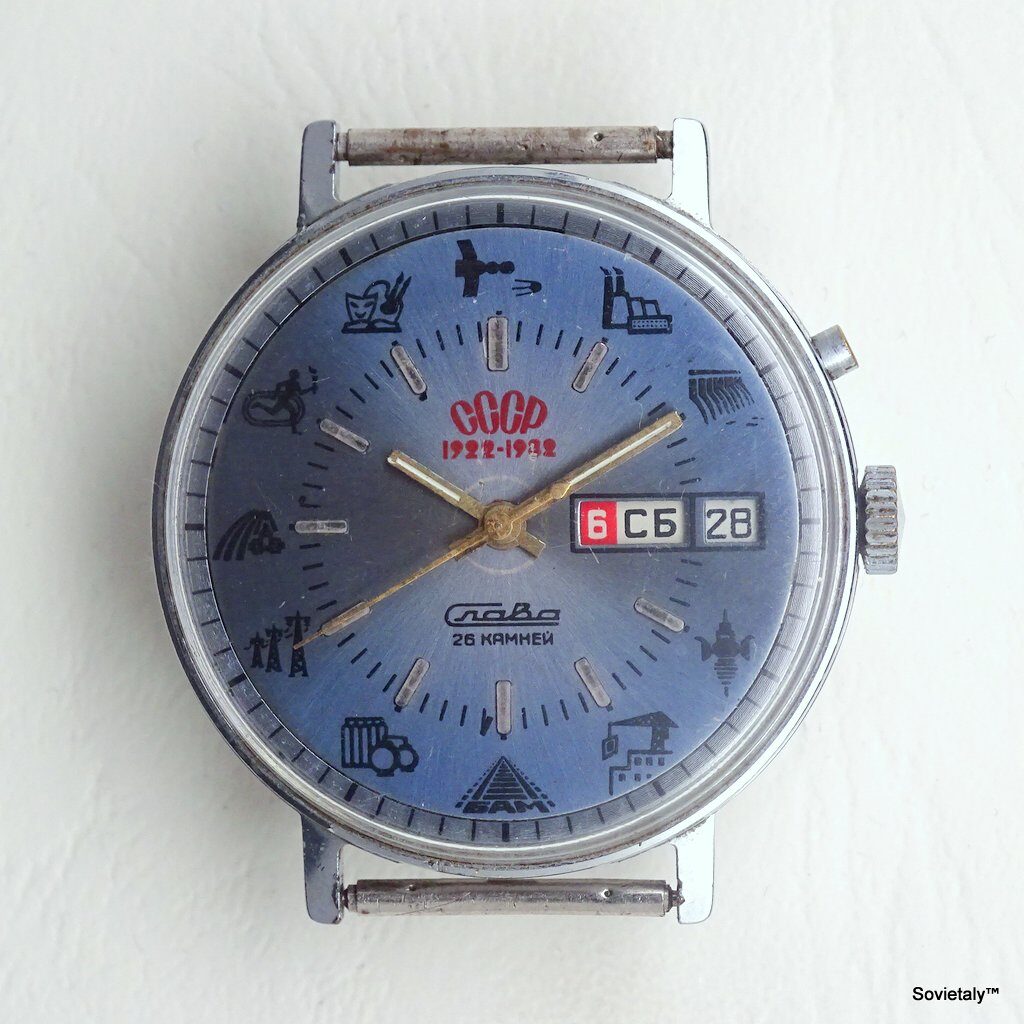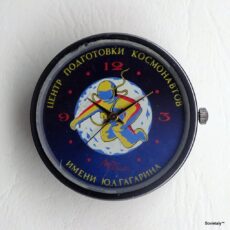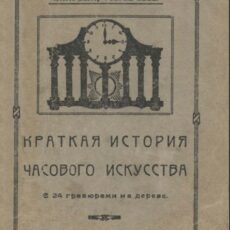The Slava commemorative watches, created to honor the 60th anniversary of the Soviet Union from 1922 to 1982, are adorned with symbolic images that celebrate the significant achievements of the USSR. Each hour marker on these unique timepieces is embellished with an icon that highlights a notable Soviet accomplishment during this period. Here is a detailed analysis of each image, providing a deep dive into the historical context and significance of these milestones.

Detailed Analysis of Each Hour Marker
1:00 – Atomic Energy
At 1 o’clock, the icon represents atomic energy, specifically highlighting the development of nuclear power plants. The Soviet Union was a global leader in nuclear technology, opening the world’s first civilian nuclear power plant in Obninsk in 1954. This plant marked the beginning of the peaceful use of nuclear energy, contributing significantly to the USSR’s electricity supply and showcasing its scientific and engineering capabilities. This development was part of the broader Soviet push for technological advancement during the post-war period, often highlighted in the successive Five-Year Plans that prioritized energy production (Encyclopedia Britannica).
2:00 – Hydroelectric Dams
The 2 o’clock position features a depiction of a massive hydroelectric dam, likely representing the Bratsk Dam on the Angara River, completed in 1967. At the time of its completion, it was the largest hydroelectric power station in the world, with a capacity of 4,500 megawatts. The Bratsk Dam symbolized the Soviet Union’s industrial strength and its ability to undertake and complete massive infrastructure projects that had far-reaching impacts on energy production and regional development. This project was a significant achievement of the 1956-1960 Sixth Five-Year Plan, which emphasized the development of Siberia and the Far East (Encyclopedia Britannica).
3:00 – (Vuota)
Questa posizione è occupata dal datario.
At 4 o’clock, the icon depicts the shipyards and repair docks in Murmansk, which were essential to the Soviet Union’s naval capabilities. These facilities, established during and after World War II, played a crucial role in the maintenance and repair of the Soviet Navy’s fleet. Murmansk, located in the Arctic Circle, provided strategic access to the Atlantic Ocean and was vital during the Cold War for both military and commercial maritime operations. The development of these facilities was part of the post-war reconstruction efforts and subsequent Five-Year Plans that aimed to rebuild and modernize the Soviet Navy (Russia Beyond).
5:00 – Major Construction Projects
The 5 o’clock marker symbolizes the Soviet Union’s extensive construction endeavors, including the building of major infrastructure such as roads, bridges, and public buildings. The Soviet government undertook massive construction projects to modernize cities and rural areas, improve transportation networks, and build iconic structures like the Moscow Metro, which became renowned for its efficiency and architectural beauty. These efforts were central to the Third and Fourth Five-Year Plans, which focused on rebuilding and expanding urban infrastructure following the devastations of World War II (Vintage Watch Inc).
6:00 – Baikal-Amur Mainline (BAM)
The icon at 6 o’clock represents the Baikal-Amur Mainline (BAM), a monumental railway project that extended over 4,000 kilometers across Siberia. Initiated in the 1930s and completed in the 1980s, BAM was one of the most challenging infrastructure projects in Soviet history. It provided a crucial transportation link in remote regions, promoting economic development and strategic military logistics in Eastern Siberia. The construction of BAM was prominently featured in the Eighth (1966-1970) and Ninth (1971-1975) Five-Year Plans, which emphasized the development of transportation infrastructure (Encyclopedia Britannica).
7:00 – Gas Industry
The 7 o’clock position highlights the Soviet gas industry, depicting gas storage and processing facilities. The USSR was one of the world’s largest producers of natural gas, with vast reserves in Siberia and Central Asia. The development of the gas industry played a critical role in the Soviet economy, providing energy for domestic consumption and export revenue through extensive pipeline networks that supplied gas to Europe. The expansion of the gas industry was a key component of the Tenth Five-Year Plan (1976-1980), which aimed to boost energy production and exports (Russia Beyond).
8:00 – Electrification
At 8 o’clock, the image of electricity pylons symbolizes the electrification of the Soviet Union. The GOELRO plan, launched in the 1920s, aimed to electrify the entire country and was one of Lenin’s most ambitious economic policies. By the 1930s, the plan had successfully increased the number of power plants and expanded the electrical grid, significantly boosting industrial and agricultural productivity and improving living standards across the USSR. This initiative laid the groundwork for the electrification targets in subsequent Five-Year Plans, particularly the First (1928-1932) and Second (1933-1937) plans (Encyclopedia Britannica).
9:00 – Agricultural Planning
The 9 o’clock marker features a tractor and agricultural fields, representing the achievements in agricultural planning and mechanization. The collectivization of agriculture, initiated in the late 1920s and 1930s, aimed to consolidate individual farms into large, state-run enterprises to increase efficiency and output. Despite initial disruptions, the introduction of modern machinery and scientific farming techniques eventually led to significant increases in agricultural production. These efforts were central to the First (1928-1932) and Second (1933-1937) Five-Year Plans, which focused on transforming Soviet agriculture (Encyclopedia Britannica).
10:00 – Moscow Olympics 1980
The icon at 10 o’clock shows an athlete holding an Olympic torch, commemorating the 1980 Summer Olympics held in Moscow. Despite the boycott led by the United States, the Moscow Olympics were a major event, showcasing the USSR’s cultural and sporting achievements. The games were seen as a demonstration of Soviet organizational capabilities and provided a platform for Soviet athletes to excel on the international stage. The successful hosting of the Olympics was a significant achievement of the Brezhnev era, highlighting the nation’s ability to stage a major international event despite geopolitical tensions (Russia Beyond).
11:00 – Arts and Culture
At 11 o’clock, the image depicts a theatrical mask and a painter’s palette, symbolizing the rich cultural heritage of the Soviet Union. The USSR placed a strong emphasis on the arts, promoting theater, music, literature, and visual arts as tools for ideological and cultural expression. Renowned institutions like the Bolshoi Theatre and artists such as Sergei Prokofiev and Marc Chagall contributed to a vibrant cultural scene that left a lasting legacy on global art and culture. Cultural development was consistently supported through various Five-Year Plans, which allocated resources to artistic and cultural institutions (Vintage Watch Inc).
12:00 – Space Exploration
The icon at the 12 o’clock position features the Salyut space station and the Sputnik satellite, symbolizing the USSR’s pioneering efforts in space exploration. In 1957, the Soviet Union launched Sputnik 1, the first artificial satellite, marking the start of the space age. This achievement not only demonstrated Soviet technological prowess but also initiated the space race with the United States. The Salyut program, beginning in 1971, introduced the world’s first space stations, paving the way for long-duration human spaceflight and significant scientific experiments in microgravity (Vintage Watch Inc).

Conclusion
The Slava commemorative watches are more than just timepieces; they are historical artifacts that encapsulate the triumphs of the Soviet Union over six decades. Each icon tells a story of innovation, resilience, and progress, reflecting the diverse achievements that defined the USSR from 1922 to 1982. These watches serve as a testament to the enduring legacy of Soviet accomplishments in various fields, from space exploration to cultural development.
By examining these intricate icons and understanding the context behind each one, we gain a deeper appreciation for the monumental efforts and achievements of the Soviet Union during a transformative period in world history.
Contents
- 1 Detailed Analysis of Each Hour Marker
- 1.1 1:00 – Atomic Energy
- 1.2 2:00 – Hydroelectric Dams
- 1.3 3:00 – (Vuota)
- 1.4 4:00 – Naval Repair Yards
- 1.5 5:00 – Major Construction Projects
- 1.6 6:00 – Baikal-Amur Mainline (BAM)
- 1.7 7:00 – Gas Industry
- 1.8 8:00 – Electrification
- 1.9 9:00 – Agricultural Planning
- 1.10 10:00 – Moscow Olympics 1980
- 1.11 11:00 – Arts and Culture
- 1.12 12:00 – Space Exploration
- 1.13 Conclusion





